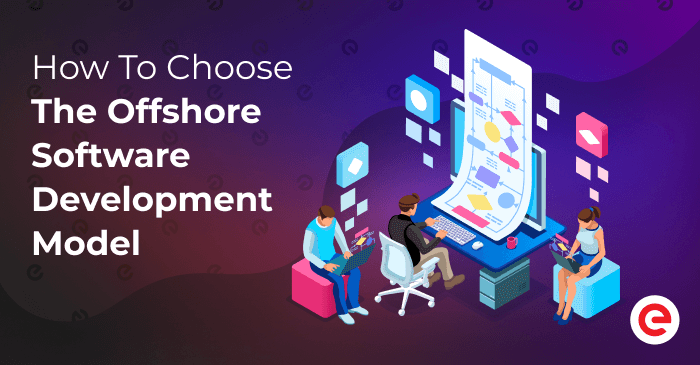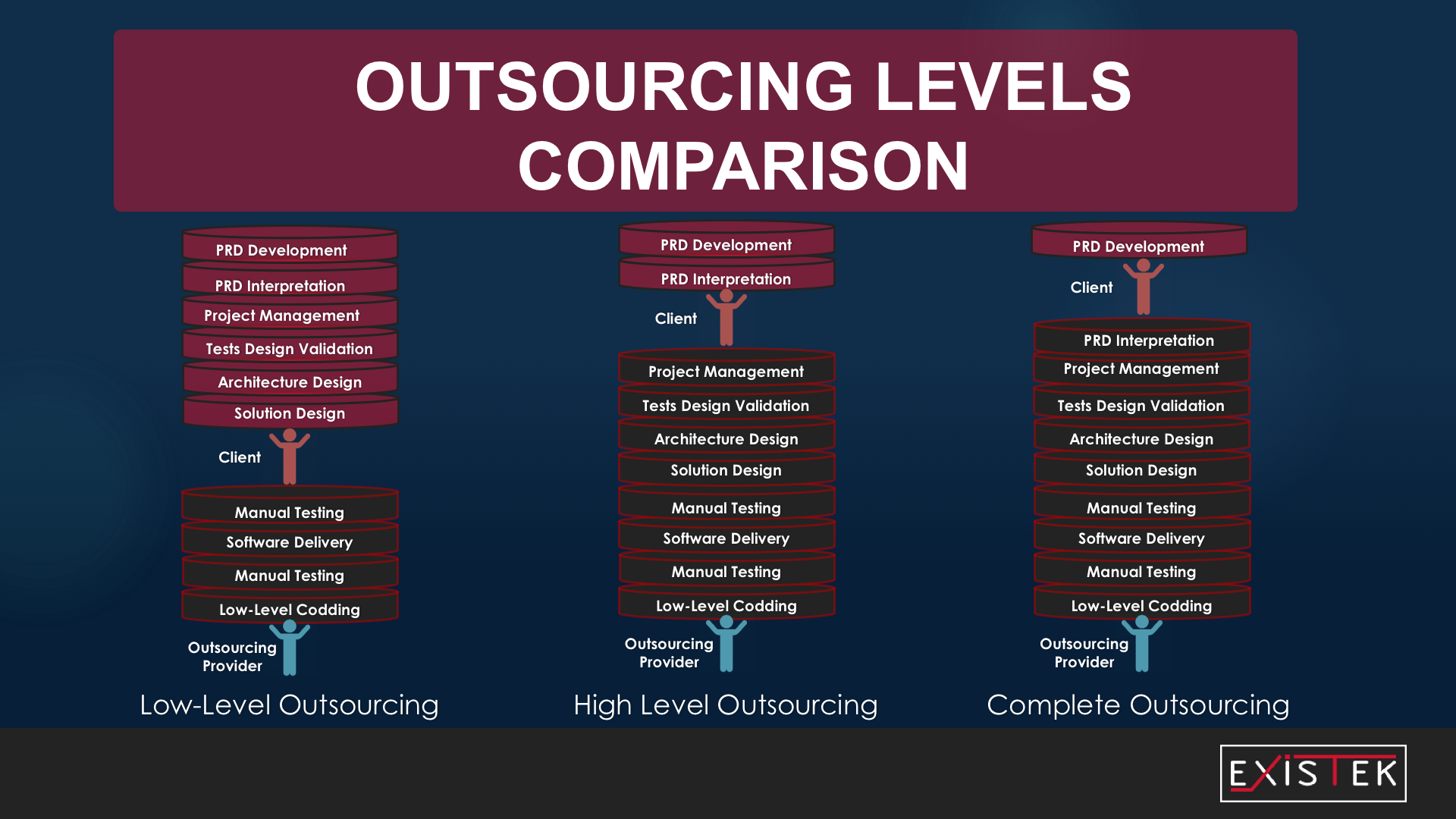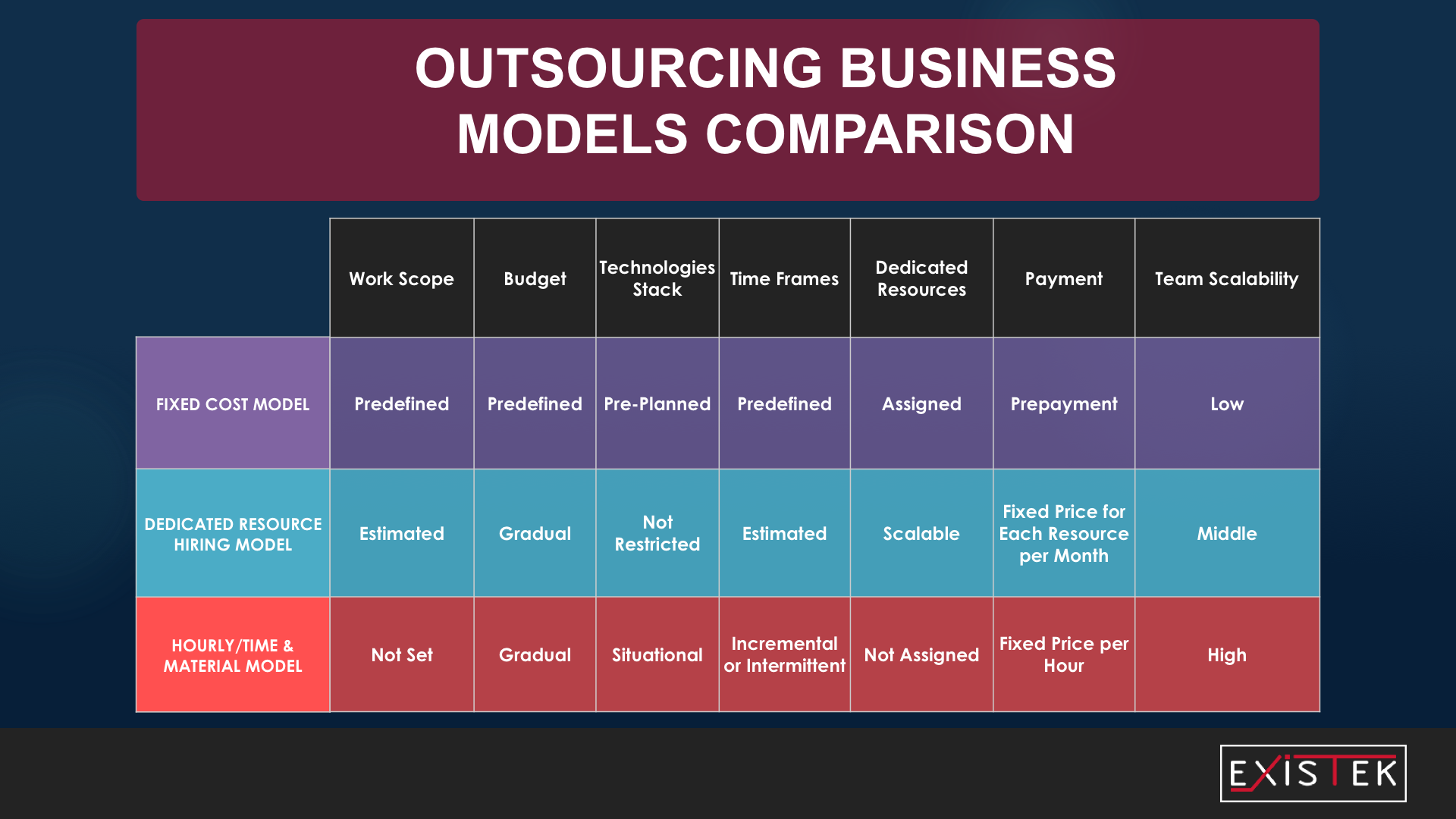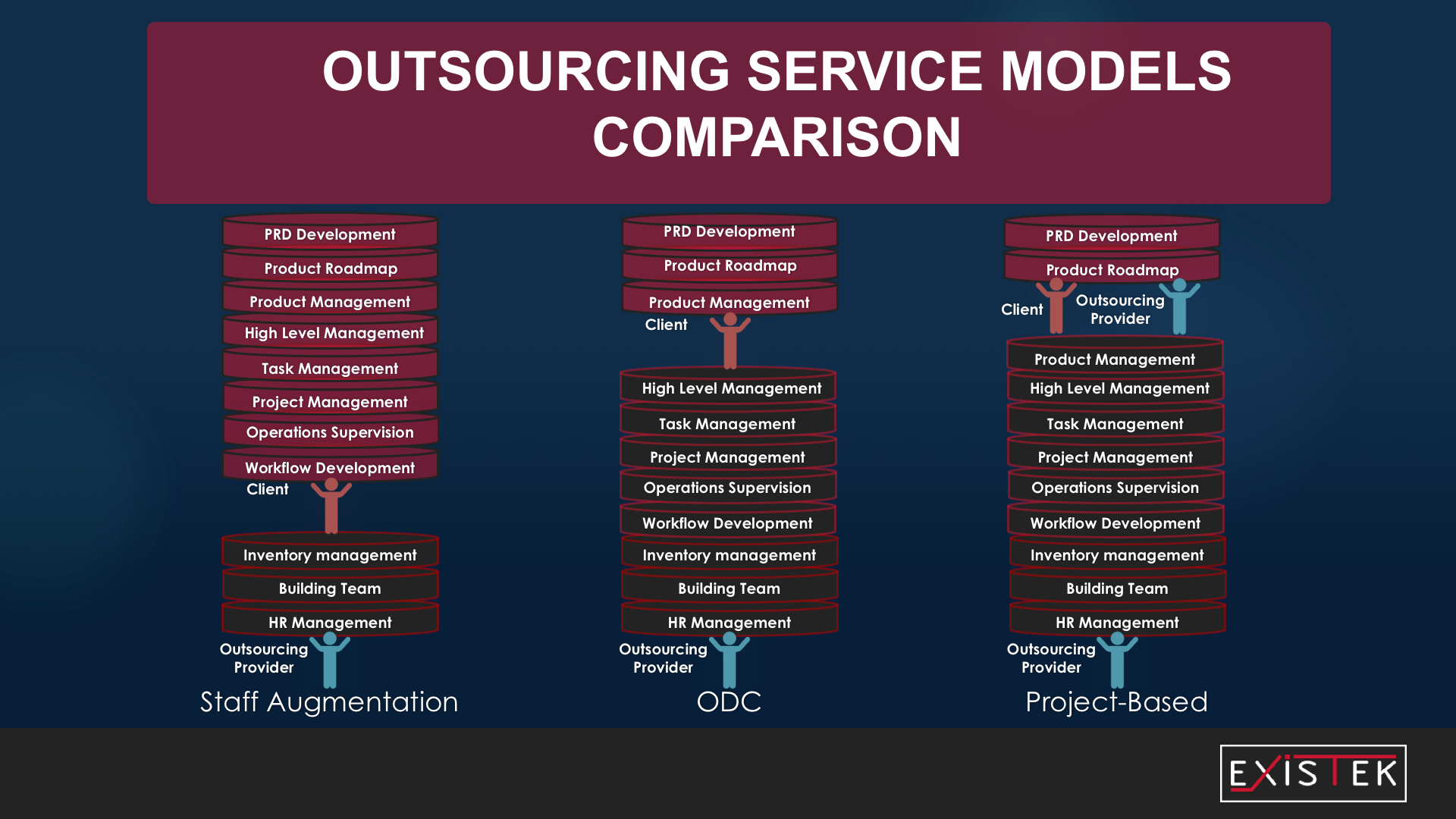
Updated: May 10, 2024
Published: July 18, 2017
The offshore software development model now is evolving by leaps and bounds. For those who have doubts which level of outsourcing or business model will suit their business objectives best, we introduce this article. Here we present main aspects of the offshore software development models for outsourcing.
So, the software development outsourcing models can be categorized into the following groups:
OFFSHORE SOFTWARE DEVELOPMENT MODEL BY LEVELS
Choosing a form of partner relationship, the first that is noticed, is how the customer wants or can control the amount of work performed by the contractor. The level of such coordination defines access to the resource base from both sides, involved in the realization of the business project. Based on these indexes, the forms of the cooperation are classified the next way:
- Low-level Outsourcing
- High-level Outsourcing
- Complete Technical Outsourcing
It is natural, that every enterprise is trying to look for the best contractor for the outsourcing project. This implies, that customers are trying to find the most experienced and highly professional players in the outsourcing market. But on the other hand, the more experienced is the contractor – the higher price for his services the customer needs to pay. Even for the small projects.
LOW-LEVEL OUTSOURCING
So here the low-level offshore software development model comes in. At the beginning of the outsourcing services provider career, the newcomers always try hard to be noticed and demanded in the future. Moreover, the price is mostly more than attractive for the customer. In a low-level offshore software development model, the product management is left within the customer company. But development and QA processes are shared with outsourcing. As for development processes, low-level solution coding and software delivery are outsourced in this model. In QA it is manual testing and test development.
HIGH-LEVEL OUTSOURCING
High-level outsourcing, like the previous offshore software development model, leaves the product management inside. As well in the QA outsourcing team design and perform tests under in-house supervision. The difference here is that the project management, solution, and test design are passed to the offshore development center. The rest is still left under in-house supervision. Outsourced processes are controlled by the architect-level software engineers: developers approve code design and interpret PRD, architect-level testers approve tests and interpret PRD.
COMPLETE TECHNICAL OUTSOURCING
In this case, the name speaks for itself. In this offshore software development model, internal processes basically contain product requirements document development. Still, all the technical aspects are outsourced: PRD interpretation, solution design, solution development, and solution implementation.
OFFSHORE DEVELOPMENT BY BUSINESS MODELS
As from the economic perspective, outsourcing engagement into the development allows to significantly reduce costs for one or the other project. The reason is that company will not need to maintain additional structure and enlarge in-house development department. All the offshore development business models are the perfect fit for those, who have decided to pay only for the resources they are actually used or the development sprints actually delivered. Working with the in-house team is always related to the unavoidable idle time of some employees here and there during the project implementation. It is hard to hire an employee who is willing to work only for a few months and start the job search once again. In this case, dedicated developers or IT staff augmentation come to the rescue.
The commonly accepted IT offshore outsourcing business models or billing models are listed below:
- Fixed Cost Model
- Dedicated Development Team or Dedicated Resources Model
- Hourly / Time & Material model
FIXED COST MODEL
One of the safest offshore development outsourcing model is the ‘Fixed Cost Outsourcing’. The fixed cost offshore outsourcing is very beneficial engagement model for the small and medium scale enterprises, thanks to the fixed pricing. This is widely used practice in such cases since the budget is fixed even before the project kick off to eliminate the possibility of hidden and unexpected costs. Considering the fact that start-ups and SMEs are often limited financially, this model helps them to feel safe and be sure that they will not run out of the budget before they have a final product in their hands.
DEDICATED DEVELOPMENT TEAM OR DEDICATED RESOURCES MODEL
This offshore software development model is team-based. That means, that the base factor of project success – is the offshore developers. The dedicated development team is the source of all the technologies, architecture, and produced code. A dedicated team is a profile unit which is involved in one project at a time, which is mostly used to release some big volume product or system. As such project development is a long-going process that lasts for all its existence time, the permanent team for its support is required. When the active development stage comes to an end, the most of the developers can be dismissed, except for the few specialists to maintain and supervise the code and its future improvement.
HOURLY OR TIME & MATERIAL MODEL
Hourly or “time & material” billing is a narrowly aimed offshore software development model. It is used mostly when the total scope of work cannot be estimated. The nature of this kind of project is vague, and a dedicated developer cannot be assigned. The volume of work can change during the work progress. But the time frames are preliminarily established, so this term can’t be shifted. Within this model, the applications developed are small or midsize and don’t require allocation resources. In this model, the client is charged for the actual amount of time and efforts spent by the software engineers on the project realization.
You can learn more about the outsourcing services billing models in our blog post “Introduction to The OutsourBillingiling Models“.
See detailed look at software outsourcing pricing and the hourly rates card in “2017 Global Custom Software Development Rates Guide“
OFFSHORE SOFTWARE DEVELOPMENT MODEL BY SERVICES
One more aspect that is obligatory to be mentioned in when speaking of the offshore outsourcing is the classification of the service models. The choice of the service model depends on the volume of the project, but also has its influence. The service model chosen will indicate the part of work shared between in-house and offshore teams.
- Staff Augmentation
- Offshore Development Center
- Project-based
STAFF AUGMENTATION
This is a relatively simple offshore software development model when compared with the others. Staff augmentation enables companies to empower the in-house staff with offshore developers as they are fully-fledged part of the team. The main advantage of the staff augmentation is the ability to engage with the occasionally needed developers only when the customer actually needs them and avoid wasting budget for the people “on the bench”. Although it requires the client to manage augmented staff directly. Routine development or testing, for example, can be performed by the offshore or nearshore development resources provided by an outsourcing software development company, while the technical leadership and management of the project remain the client’s responsibility. Obviously, outsourcing services providers won’t be able to bring innovations or his expertise in this case. In fact, the lower responsibility for the final result and lack of involvement in the project steering committee, prevent outsourcing software companies from influencing the project for better or worse.
With the staff augmentation offshore software development model, the list of outsourcing contractor’s responsibilities is usually quite short. Usually, it includes routines technical stuff like the implementation and sometimes prototyping part. The vision of the product and decision scope of the members of the augmented development resources team are limited and don’t encourage them to improvise. It is essential to pre-define realistic expectations and responsibilities for both client and outsourcing contractor. For example, define who is in charge of the product development lifecycle, which usually belongs to the client in staff augmentation model. It helps the outsourcing services provider and the customer to work like a single unit and secure flawless development process.
Check our comparison of the Staff Augmentation and Managed Services with the detailed look at the advantages of each model.
OFFSHORE DEVELOPMENT CENTER
Offshore Development Center is an outsourcing model which shines in the long-term projects with the big scope of work. This model is used by all the companies who need to decrease the cost without sacrificing the quality and without lowering the available development resources. To achieve this goal, the customer chooses the offshore or nearshore software development company to pick up and form a team of experienced dedicated offshore developers from the contractor’s stuff pull. These developers are guaranteed to be engaged only in one project at a time and be fully managed by the customer. This framework allows the customer to make sure that the team will meet project requirements and will be capable of accomplishing required functionality in a timely manner. One more pretty simple but not so obvious advice is that when running a complex long-term project, it is not advised to change developers.
Consequently, the agreement usually starting with the point that the team is reserved by the particular client. The main client’s goal is to give the planned outcome in terms of the code and features. As for the engagement cost, it depends on the technologies used, level, the number of involved software development engineers. The offshore development center model is a good choice for the clients who are familiar with the intricacy and drawbacks of their project development, ready to overcome these challenges by investing in long-term business relations. The dedicated development team as the representative of all technologies, architecture, experience, and knowledge is the guaranty for the quality of the project. Moreover, they can offer domain expertise in software development for finance, manufacturing, eCommerce, healthcare, etc.
PROJECT-BASED
An offshore software development model used for projects with defined timeframes often used for projects with well-defined requirements that are most likely won’t change during the development process. This remote development model is well-known for such advantages as the cost reduction and shorter time to market. Industry experts achieve this via selecting a software outsourcing service provider with the expertise in the technologies used in the project and experience in the business vertical accordingly. However, if you feel like your needs may experience some shifts during the development or you’re operating on the quickly evolving market like payment processing it is highly recommended to use other strategic outsourcing models like dedicated development team. Also, if your engagement scope is bigger than one-time project – this model is worth your consideration too. The project-based approach is considered the most appropriate option for companies with irregular, one-off, and pilot projects of low to medium complexity with well-defined requirements and deliverables. Many of these projects turn into mutually beneficial and long-lasting relationships in the form of a dedicated development center, for instance.
SUMMARY
In general, establishing a business based on the outsourcing is simple to implement. Everyone can find a model suitable for his needs. No matter, if the startup is based on a budget available, or clients’ needs, or his skills and knowledge – there is outsourcing business model for each particular case. Moreover, these models can be easily combined for those who know how to arrange business from top to bottom and even for those who are only learning about the IT Outsourcing.
Outsourcing – is a simplification of the development process. The outsourcing team – is a scalable tool. The customer can enlarge or reduce the developer team at any stage. Unlike common hiring, where you’ll struggle to find software engineer for short engagement, the dedicated team is created for scalability. You may find lots of articles about outsourcing advantages and best practices here and there on the internet. And all these authors are focused on the same strong sides. No matter if you’re looking only for one specific specialist to fill in the gap in your in-house team for a couple of months or for the custom software development company who can create PRD for your software product from scratch and then embody it in the code.
Curious to know more about offshore development?
In the article, you’ll find out about the most common offshore development models, the difference between offshore, nearshore, and onshore, pros and cons of each model, and tips on finding the best software provider.
Still, picking up a right business and engagement model is not an easy task. The stakes are high and every enterprise and SMEs should consider the fact that correct evaluation of project scope and resources needed to make it to the finish is the foundation of any custom software development project success. Here, at Existek we’ve completed numerous offshore outsourcing projects and know exactly which approaches actually work with different types of projects and capable of making a precise estimate of the resources needed to get the job done. Contact Us and we’ll consult you on selecting the model that will suit your specific business case or visit our Services Page to learn more about us.



